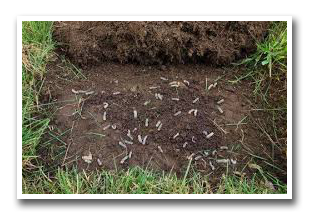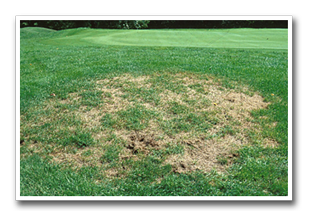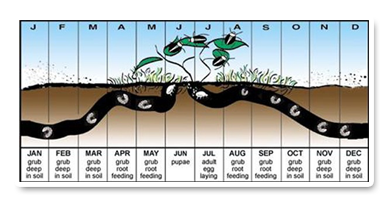Grub & Insect Control
 Lawn Grubs
Lawn Grubs
Lawn grubs, often called white grubs, are the immature form of different scarab beetles, such as Japanese beetles, June "bugs" (beetles) or the European chafers. These white, C-shaped creatures have soft bodies with legs near the head. They feed on grass roots (and organic matter in the soil), causing sections of grass in the lawn to die. Grubs eventually turn into adult beetles and emerge from soil to mate and lay eggs, which hatch into more grubs.
Most scarab beetles have a one-year life cycle; June beetles have a three-year cycle. Timing varies by beetle species and region, but generally adults emerge from soil, mate, and lay eggs over the course of two to three weeks in early to midsummer.
 Depending on soil moisture and temperature, eggs hatch about two weeks after being laid,
in mid- to late summer. The new generation of root-munching grubs begins feasting immediately after hatching.
Depending on soil moisture and temperature, eggs hatch about two weeks after being laid,
in mid- to late summer. The new generation of root-munching grubs begins feasting immediately after hatching.
Peak grub feeding occurs in early fall. Typically grubs operate a few inches below the soil surface, but burrow deeper (up to 8 inches in northernmost areas) before winter arrives.
As your lawn greens up in spring, keep an eye out for brown patches that never turn green. Those dead patches may be due to grub feeding that occurred the previous fall. To check, lift a piece of your turf. If grubs are the culprit, the dead patch will roll up like a carpet, or you'll be able to pull up the grass and see that it has no roots.
 Irregularly shaped dead patches appear in your well-irrigated lawn in late summer or early fall.
Check your turf using the technique just mentioned.
Irregularly shaped dead patches appear in your well-irrigated lawn in late summer or early fall.
Check your turf using the technique just mentioned.
Birds, skunks, armadillos, raccoons or moles are tearing up your lawn – they eat grubs and are trying to uncover them. These animals also dig and eat earthworms, so confirm grubs are present before pursuing any treatment.
